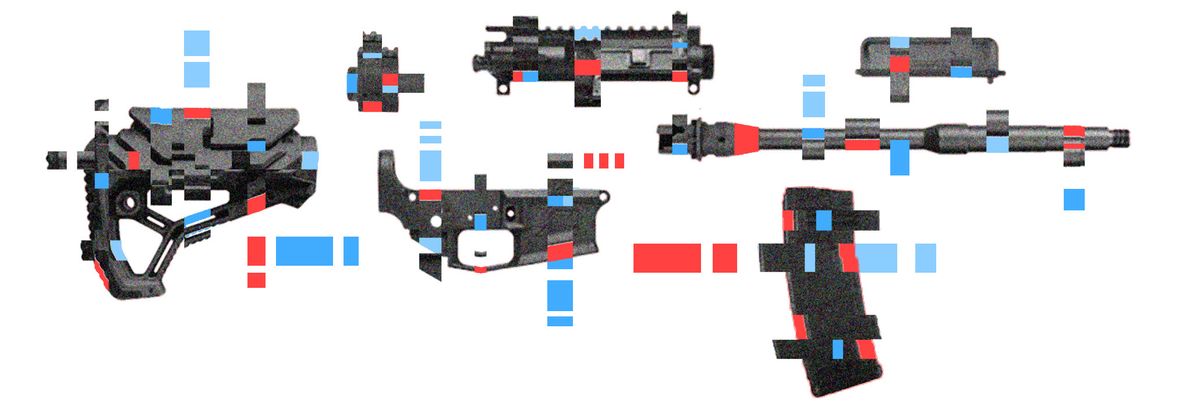How to Build Resentments (List of Parts)
by Dorian Fox | Taking stock.

Upper Receiver
You (expert that you are) might call this simply “an upper.” There are four types of upper receiver, similar in function to a car chassis: a platform to which interchangeable parts of the AR-15 rifle attach. With such variety, so much is possible. On that, we can agree. The original upper receiver dates to the Vietnam War and supported military M-16s. Our era’s hole-punched school lockers are descended from jungle firefights circa 1965. They share bloodlines. The patriarch: Eugene Stoner, firearms designer. He died from cancer at age seventy-four and was—I cannot stress this enough—extremely good at his job.
Handguard
While firing, heat from the barrel can burn the skin. Hence the guard. Your hands are chewed up: gnarled knuckles, purplish black around the nail beds, a topography of scars earned through years of stripping siding, pounding shingles. Your daily grind. Weekends, it’s improvements for the home you share with my sister and your children, my nephews and niece. Your boys grapple on giant stones you rocked into place. At my parents’ house, they climb halfway up the stairs and jump, flailing, into my arms. Each time, I worry about misjudging my grip, feeling them slip, tumble.
Barrel
The longer the barrel, the more velocity a bullet generally achieves upon exiting a muzzle. More velocity equals more force, more impact, more “stopping power.” What do you imagine stopping? Eight-point bucks? Bad guys? Life? The feeling of moving through a world that is so much bigger than us? A world you fear you are not able to bend, or master?
Gas Block
The combustion of each fired round creates a burst of gas, a portion of which flows back into the weapon through a narrow tube, creating pressure, helping to chamber the next round. A gas block, clamped over the barrel’s port, prevents too much gas from traveling into the tube. Tactical websites admit the process is complicated. Remember the time you asked me, in the midst of a social media exchange, what I would do if a man with a gun kicked down my door while my wife and I slept? My hands shook, typing a reply. I worry as much about violent burglary, I wrote, as I do about my house being struck by lightning. You said your house has been struck by lightning twice. Well, you had me there, I had to admit. I posted an emoji with my response, the one laughing so hard it’s crying.
Buffer
A metal cylinder containing weights, the buffer offsets the rifle’s recoil, increasing stability and improving aim. My sister says, “I was so anxious watching you guys argue on Facebook.” In our discussions, we never mention her. We don’t discuss her feelings. Eventually, after a particularly harsh exchange, she will ask you to unfriend me, and when I notice your disappearance from my feed, I will feel a bolt-catch of loss, then a wave of relief.
Lower Receiver
This is the only part considered a firearm by itself, with nothing attached, nothing joined. For that reason, it cannot be shipped directly to homes in the United States; current law requires an in-person background check by a licensed seller. I imagine you trading cracks with the clerk, him rolling his eyes as he asks for your ID, apologetic. A comrade.
Magazine
In another online dialogue, after a man with a long gun and a high-capacity magazine murdered dozens of people, you brought the First Amendment into the conversation. My right to free speech, you asserted, demands the same respect as your right to bear arms. No limits. Shall not be infringed, you wrote. Words, I argued, can harm, but they cannot kill. They cannot take a life. But maybe that’s not entirely true. The Constitution is a story. America is a story. Marketing is a story. More and more, I am trying to understand where violence starts.
Ejection Port Cover
Metal or plastic, hinged, the cover protects the port where spent cartridges are ejected, keeping out dust and debris. Taking care of the weapon’s insides is important, the websites say. Covers can be custom engraved with images or text: skulls, odes to freedom, billowing flags. To me, the part resembles a pair of sunglasses, so dark you can’t see through.
Stock
Braced against the shoulder, this part (also known as a shoulder stock, or buttstock, or butt) transmits recoil into the shooter’s body. After a mass shooting, sales of firearms tend to enjoy a bump. Lines at gun shops spill onto sidewalks. Gun manufacturers amplify their messaging, target you and your friends.
I am taking stock: Newtown. Orlando. San Bernardino. Sutherland Springs. Las Vegas. Parkland. Gilroy. Pittsburgh. El Paso. Buffalo. Highland Park. Uvalde. Nashville. I don’t know where all the dead might dwell, in your mind. I don’t know how to avoid connecting A to B, access to atrocity, tactical ads to grief, your feeling of safety to my feeling of risk.
If only we could construct our arguments from something more honest. If only we could admit we are afraid of one another, afraid for one another.
The stck stck stck of semiautomatic fire, heard from a distance, heard through walls.
Every time, I feel it—moving parts, clicking.
Dorian Fox is a writer and freelance editor whose essays and articles have appeared or are forthcoming in Brevity, the Rumpus, Gay Magazine, Booth, the Pinch, McSweeney’s Internet Tendency, Los Angeles Review of Books, and elsewhere. He lives in Boston and teaches creative writing courses through GrubStreet and Pioneer Valley Writers’ Workshop. Learn more about his work at dorianfox.com.
This essay is a Short Reads original.
Support our efforts: ☕ buy us a coffee.






